The Ha Giang Loop is an unforgettable journey through Northern Vietnam. Are you wondering if Du Gia, a serene village known for its natural beauty, is part of the standard Ha Giang Loop experience? SIXT.VN is here to guide you through the intricacies of planning your adventure, ensuring you discover hidden gems and create lasting memories. Let’s explore whether Du Gia features in the typical route and how you can make the most of your Ha Giang exploration with personalized Vietnam travel advice.
1. What Is the Ha Giang Loop?
The Ha Giang Loop is a multi-day motorbike route, approximately 350 km (217 miles), traversing the Ha Giang province in Northern Vietnam, near the Chinese border. It’s celebrated for its dramatic mountain passes, winding roads, and picturesque villages inhabited by Vietnam’s diverse ethnic minorities like the Hmong, Red Dao, and Tay.
 Motorbike Adventure on Ha Giang Loop
Motorbike Adventure on Ha Giang Loop
1.1. A Road Built on Dreams
From 1959 to 1965, thousands of local workers and volunteers constructed this road, mostly by hand, through challenging terrain. It was nicknamed “Happiness Road” for uniting rural Vietnam and providing locals with greater opportunities. According to historical records from the Vietnam National Administration of Tourism (VNAT), the road significantly boosted economic development in the region after its completion.
2. Understanding the Ha Giang Loop Route
The Ha Giang Loop generally follows this route, which can also be done in reverse:
- Start in Ha Giang city
- Travel to Yen Minh and Dong Van
- Visit Lung Cu Tower to the north
- Return to Dong Van
- Head to Ma Pi Leng Pass and Meo Vac village
- Loop back toward Ha Giang, passing through Mau Due and potentially Du Gia
2.1. Is Du Gia Always Part of the Plan?
Du Gia is often included in the final stretch of the loop. However, the specific route can vary depending on the tour operator or your personal preferences. SIXT.VN can help you tailor your itinerary to ensure you experience the destinations that resonate most with you.
A detailed map showcasing various route options for the Ha Giang Loop, highlighting the flexibility in planning your journey. Notice the different paths one can take to customize their adventure.
3. How Many Days Should You Dedicate to the Ha Giang Loop?
The Ha Giang Loop typically takes between 2 to 4 days. While 2 days can feel rushed, 3 days/2 nights is a common choice. A 4-day/3-night trip offers a more relaxed exploration.
3.1. Why Choose a Longer Itinerary?
A longer itinerary allows for deeper immersion into the local culture and more time to enjoy the scenic beauty. According to a survey conducted by TripAdvisor in 2023, travelers who spent at least 4 days on the Ha Giang Loop reported higher satisfaction rates due to the ability to explore more remote areas and engage with local communities.
 Scenic View on the Ha Giang Loop
Scenic View on the Ha Giang Loop
 Picturesque Nho Que River on the Ha Giang Loop
Picturesque Nho Que River on the Ha Giang Loop
4. Exploring Beyond the Loop: Our Extended Route
We opted for a 6-day adventure, extending the Ha Giang Loop to include the Cao Bang province, offering a richer experience of Northern Vietnam.
4.1. The Cao Bang Extension
Our route included:
- Pac Bo
- The famous Ban Gioc waterfall
- Angel Eye Mountain
- Cao Bang city
- Ba Be Lake
This extension provided a unique experience, allowing us to explore areas with fewer tourists.
4.2. Why Extend Your Journey?
Extending your journey allows you to discover hidden gems and untouched landscapes. According to a report by the Vietnam National Administration of Tourism (VNAT) in 2023, regions beyond the typical Ha Giang Loop, such as Cao Bang, offer a more authentic cultural experience and less crowded attractions.
Capture unforgettable memories as you explore the scenic Ha Giang Loop. This photo represents the freedom and beauty that awaits on your motorbike adventure.
5. Should You Hire a Guide for the Ha Giang Loop?
While not mandatory, hiring a guide is highly recommended for the Ha Giang Loop.
5.1. Legal Requirements
Depending on your license and country of origin, a guide may be legally required. An International Driving Permit (IDP) is necessary, but only IDPs from countries under the 1968 Vienna Convention are valid in Vietnam.
5.2. Benefits of Having a Guide
- Safety: Guides are experienced with the local roads.
- Cultural Immersion: They offer insights into the local culture.
- Logistics: Guides handle food and lodging arrangements.
Our guides, Nô Vàng and Hieu, enriched our experience, becoming like family. They took us to Nô Vàng’s home village, an opportunity we wouldn’t have had on our own.
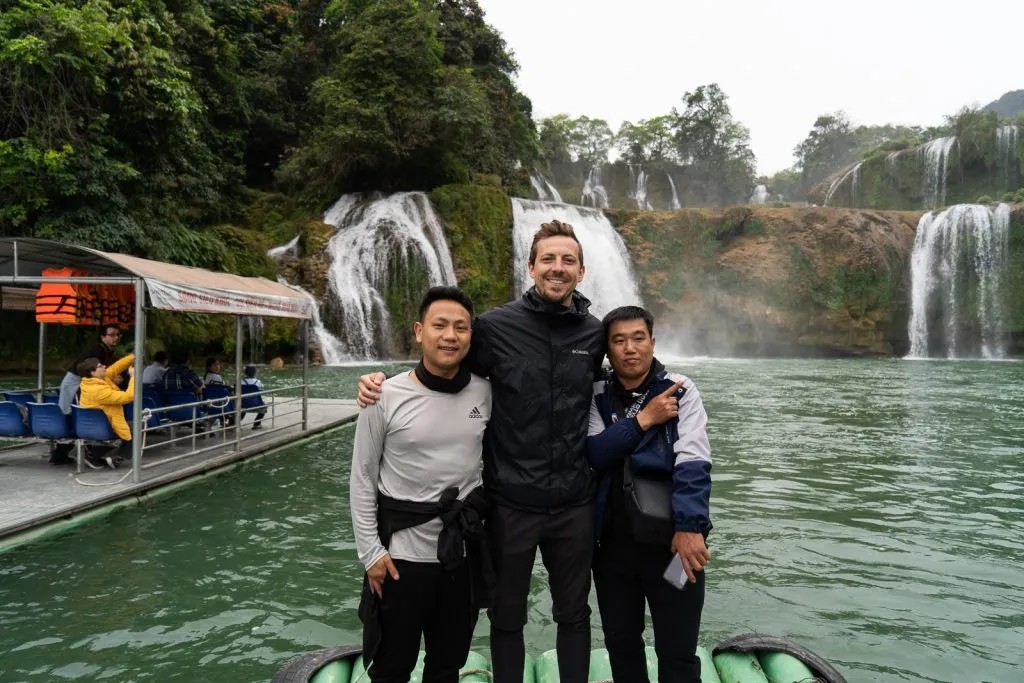 Scenic View of Rice Paddies in Cao Bang
Scenic View of Rice Paddies in Cao Bang
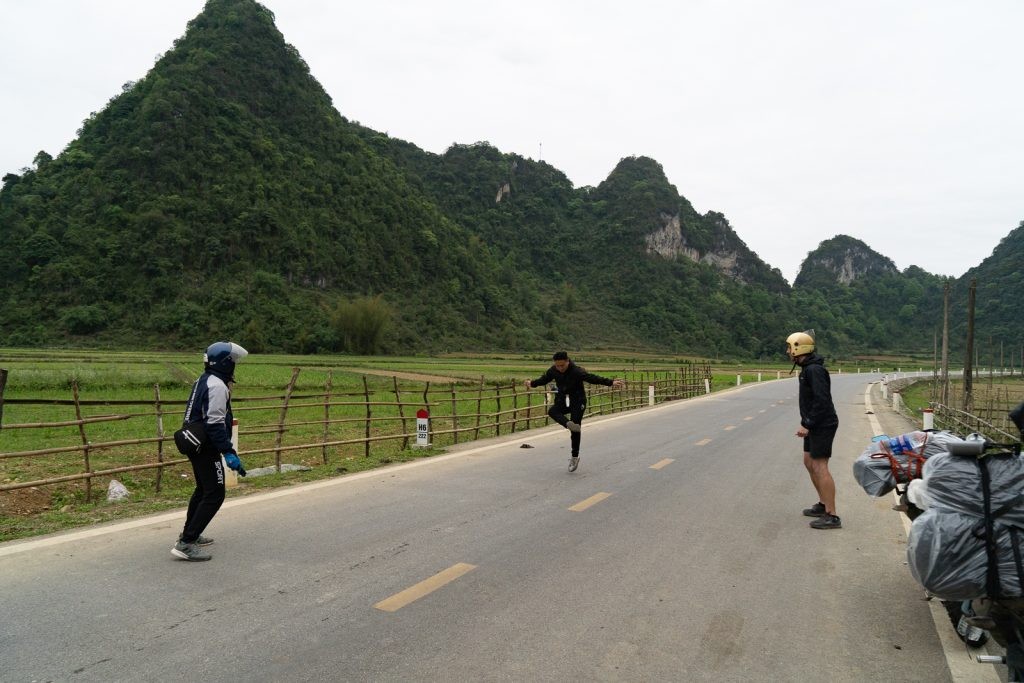 View of Cao Bang, Northern Vietnam
View of Cao Bang, Northern Vietnam
Feel the freedom as you ride through the stunning landscapes of Northern Vietnam. A guide ensures a safe and immersive adventure.
Marvel at the breathtaking mountain views along the Ha Giang Loop. With a guide, every turn reveals a new perspective on this stunning landscape.
5.3. Motorbike Laws in Vietnam
It’s essential to adhere to Vietnamese motorbike laws. You need an IDP that Vietnam recognizes. Without a valid IDP, you can only legally drive motorbikes 50cc or less, which are not suitable for the mountainous terrain of the Ha Giang Loop. Helmets are required by law for all motorbike riders and passengers.
5.4. Easy Rider Option
If you can’t or prefer not to drive, consider hiring an easy rider—a guide who drives the motorbike while you ride as a passenger. This is a comfortable way to enjoy the scenery without worrying about navigation.
 Easy Rider on the Ha Giang Loop
Easy Rider on the Ha Giang Loop
5.5. Group vs. Private Tours
When booking a tour, you can choose between a group or private tour. Group tours are great for meeting other travelers, but they can be large. Private tours offer more flexibility and personalized experiences. We opted for a private tour with Ha Giang Road Trip, which allowed us to stop and film as needed.
5.6. Can You Experience the Loop by Car?
Yes, if you’re not comfortable on a motorbike, you can explore the Ha Giang Loop by car. Many tour companies offer this option.
6. Finding the Best Ha Giang Loop Tour
We recommend Ha Giang Road Trip for their excellent reviews and reasonable prices. They focus on smaller groups and handle all logistics.
6.1. Booking Your Tour
You can book shorter tours (2-4 days) on TripAdvisor or by contacting them via WhatsApp (+84.948.242.421) or email ([email protected]). Use code APLUSK10 for a 10% discount on TripAdvisor.
6.2. Communication Tips
Communication may be slow at times, so plan accordingly. Many travelers book their tours just weeks or days in advance.
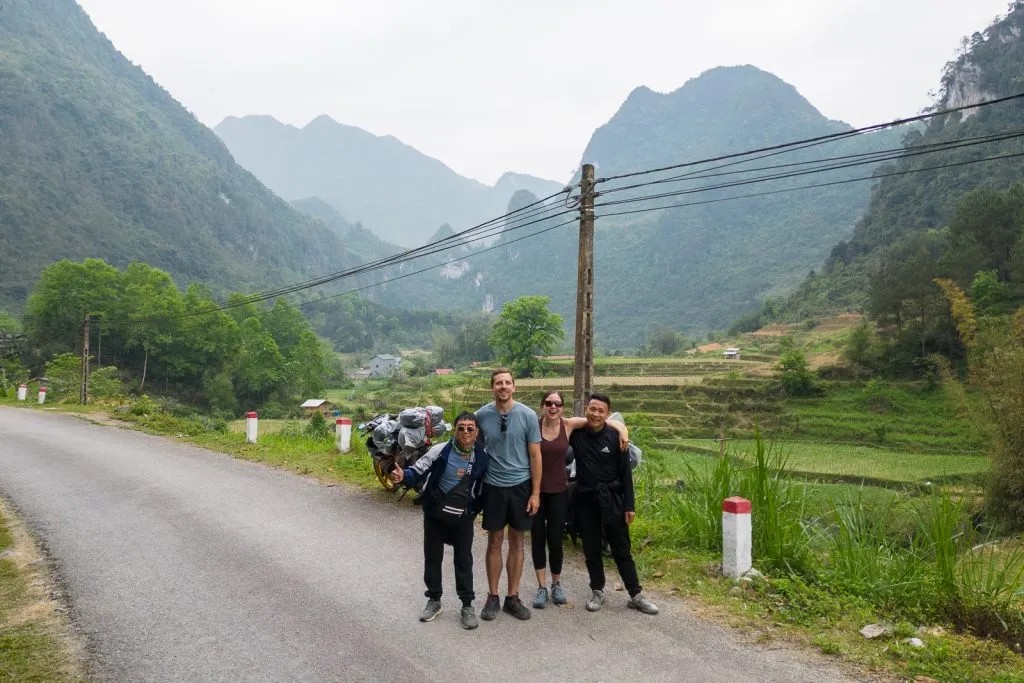 Tour Group Enjoying the Ha Giang Loop
Tour Group Enjoying the Ha Giang Loop
7. Trip Planning Logistics for the Ha Giang Loop
7.1. Getting to Ha Giang City
Ha Giang is about 5.5 hours north of Hanoi. The most common way to get there is by bus or van. You can book through your tour provider or on 12Go. We took a daytime van, which took about 7 hours with stops.
7.2. Best Time to Visit the Ha Giang Loop
The Ha Giang Loop is enjoyable year-round, but spring and fall are ideal.
- Spring (March-May): Cooler temperatures with occasional rain.
- Summer (June-August): Rainy season with muddy roads.
- Fall (September-November): Drier and most popular with golden rice fields.
- Winter: Chilly temperatures with possible icy roads.
Be aware of the Tet Holiday, as many businesses may be closed.
Experience the vibrant colors of spring as you journey through the Ha Giang Loop. The weather is perfect for exploring the stunning landscapes.
7.3. Where to Stay in Ha Giang
There are many accommodation options in Ha Giang. We stayed at Be’s Home, a hostel with private rooms. Other options include Sun Ha Giang Hotel, Tí Lầu Homestay, and Palm Ha Giang Ecolodge. Booking in advance is recommended.
Relax and rejuvenate in a cozy hotel in Ha Giang, preparing for or winding down from your epic loop adventure. Enjoy the local hospitality and comfort.
Start your day with a traditional local breakfast in Ha Giang, fueling up for the adventures that lie ahead. Savor the flavors and embrace the local culture.
Enjoy the tranquility of a homestay in Ha Giang, complete with comfortable outdoor seating. Immerse yourself in the serene atmosphere and connect with nature.
8. Frequently Asked Questions About the Ha Giang Loop
8.1. Is the Ha Giang Loop Safe?
The Ha Giang Loop is generally safe, but the roads can be hazardous. Hiring a guide can significantly improve your safety. Travel insurance is highly recommended.
8.2. What Are the Road Conditions Like?
Roads vary from smooth pavement to dirt or rugged terrain. Dry conditions are generally safe, but wet conditions require caution.
8.3. Where Can I Store My Luggage?
Tour providers offer luggage storage. Bring a small backpack for essentials.
8.4. What Is the Food Like on the Ha Giang Loop?
Expect mainly Vietnamese cuisine. Guides typically choose restaurants and order family-style meals. Dietary restrictions can be accommodated. Happy water (rice wine) is also very popular.
Enjoy a delicious family-style dinner on the Ha Giang Loop, with a variety of local dishes to sample and savor.
8.5. Where Do You Sleep Each Night?
You’ll stay in small, family-run hotels or homestays in towns and villages along the loop. Homestays offer a more boutique feel and often include meals.
8.6. Should You Book Accommodations in Advance?
If you’re on a tour, accommodations are arranged for you. If traveling independently, there are many options, but booking in advance is recommended.
8.7. What Is the Cell Signal Like on the Ha Giang Loop?
Cell service is surprisingly good throughout the loop. Consider using eSIMs from Airalo for easy connectivity.
8.8. Is the Ha Giang Loop Busy?
The Ha Giang Loop is gaining popularity. To avoid crowds, consider spending more time in the region and venturing beyond the typical loop.
8.9. How Much Does the Ha Giang Loop Cost?
Costs vary depending on the tour, duration, and whether you have an easy rider. Expect to pay $200 to $300 per person for a tour with an easy rider.
8.10. Should You Tip Your Guide?
Tipping is appreciated for good service. A good rule of thumb is $10-$15 USD per day or about 10% of the tour price.
8.11. Do Ha Giang Loop Guides Speak English?
Guides commonly speak some English, but easy rider drivers may only speak Vietnamese or their local language.
9. Discover the Best Stops Along the Ha Giang Loop
The Ha Giang Loop offers endless attractions, from tourist sites to scenic viewpoints. Hiring a guide ensures you don’t miss any hidden gems.
9.1. Ha Giang City
Ha Giang city serves as a basecamp for your Ha Giang Loop adventure. Enjoy coffee at Lofita 247 Nguyen Thai Hoc and delicious doner kebabs at Phương Hạnh DONER KEBAB Bánh mỳ.
Prepare for your adventure with scenic views of rolling hills and vibrant rice fields. Your journey starts here, amidst the natural beauty of Ha Giang.
Savor delicious local flavors with a mouth-watering Doner Kebab in Ha Giang. This savory treat is the perfect start to your adventure.
9.2. Bac Sum Pass
The Bac Sum Pass is your first major pass and landmark, offering incredible mountain views.
Journey through the majestic Bac Sum Pass, where the road winds through mountains and valleys. Capture breathtaking views from this iconic landmark on the Ha Giang Loop.
Stop to absorb the view at Bac Sum Pass. It’s where the road starts to get really mountainous and windy! There are a handful of spots to pull over and enjoy the views from up here.
The Bac Sum Pass is a scenic road offering breath taking views of the mountains! It marks the first major mountain pass along the Ha Giang Loop, where you can stop and enjoy the beautiful landscape.
The Bac Sum Pass offers a view of small homes in the distance! This is where you can catch your first glimpse of the remote villages nestled in the valleys of the Ha Giang Loop.
9.3. Quan Ba (Heaven’s Gate)
Heaven’s Gate sits around 1,500 meters (4,291 feet) and is the gateway to the Dong Van Global Karst Plateau Geopark, a UNESCO site. Enjoy views of mountains, rice fields, and villages.
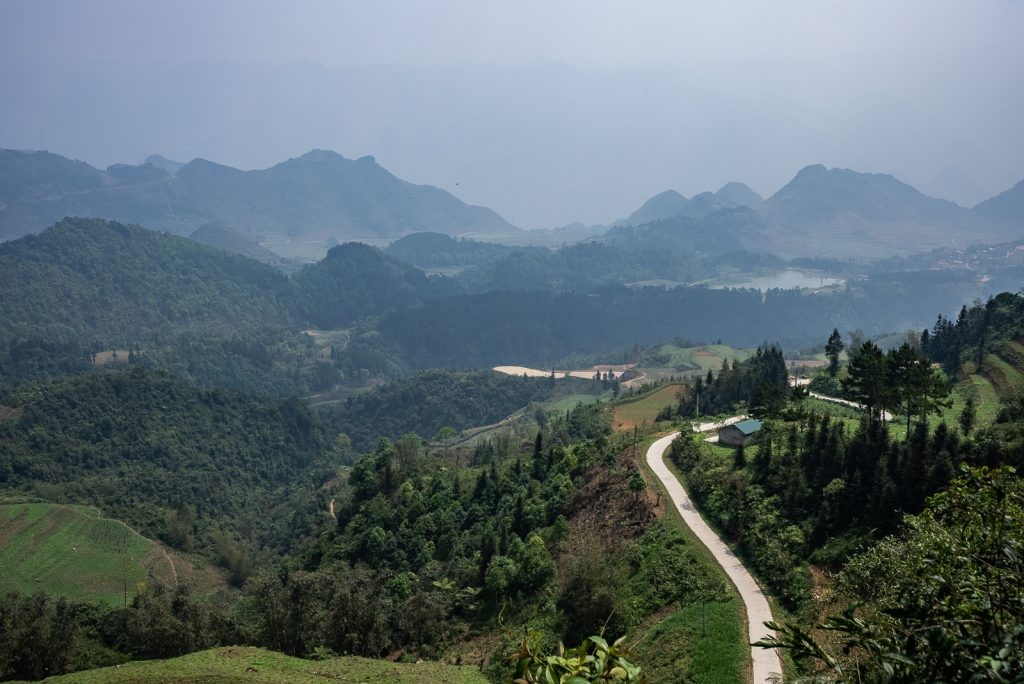 Heaven's Gate, Northern Vietnam Motorbike
Heaven's Gate, Northern Vietnam Motorbike
Heaven’s Gate is a must-see location! It is a place where you can grab drinks and enjoy the views of the mountains, rice fields, and villages.
Witness breathtaking views from Heaven’s Gate, where sweeping landscapes meet the sky. This vantage point offers an unparalleled perspective on the beauty of Northern Vietnam.
View of a cafe at Heaven’s Gate, where you can relax with a refreshing drink and soak in the panoramic vistas. It’s a perfect spot to pause and appreciate the stunning scenery.
9.4. Twin Mountains Viewpoint (aka Fairy Breast Mountains)
This quick roadside stop offers a unique view of the Twin Mountains (Fairy Breast Mountains).
The Twin Mountains, also known as Fairy Breast Mountains, a quick roadside stop to pull over and snap a few photos. It is one of the many amazing sights on the Ha Giang Loop.
9.5. Lung Khuy Cave
Explore the Lung Khuy Cave, discovered in 2015 and considered one of the most beautiful in the area.
9.6. Lung Tam Weaving Village
Learn about hemp weaving from the Hmong people in Lung Tam Weaving Village.
9.7. Yen Minh
Yen Minh is a perfect lunch stop. If you’re doing a 4-day route, it’s a good town to stay in for your first night.
Delight in a delicious meal on the Ha Giang Loop, where every dish offers a taste of local flavors and culinary traditions.
9.8. Tham Ma Pass
Tham Ma Pass is a steep road winding through a narrow mountain valley. Resist the temptation to give money to the local kids dressed in traditional attire.
Navigate the winding roads of Tham Ma Pass, where steep inclines and sharp turns reveal stunning vistas at every bend. It’s one of the most popular stops along the Ha Giang Loop!
9.9. Hmong King’s Palace
The Hmong King’s Palace, built in 1902, is one of the most important sites for the Hmong people.
9.10. Dong Van
Dong Van is a larger town with an Ancient Town area reminiscent of Hoi An. Visit on a Sunday to experience the local market.
 Dong Van, Northern Vietnam
Dong Van, Northern Vietnam
9.11. Lung Cu Flag Tower
Lung Cu Flag Tower represents the northernmost point of Vietnam, offering 360-degree views.
Ascend to the Lung Cu Flag Tower and gaze upon the biggest Vietnamese flag you’ll ever see! It has 360-degree views of the surrounding landscape.
Reach new heights at the Lung Cu Flag Pole, the northernmost point of Vietnam, where the flag waves proudly against the backdrop of stunning scenery.
Capture breathtaking viewpoints as you explore the Ha Giang Loop, where every turn reveals a new perspective on the dramatic landscape. Don’t forget your camera!
9.12. Ma Pi Leng Pass
Ma Pi Leng Pass offers epic views into the Tu San Canyon, the largest canyon in Southeast Asia.
Traverse the breathtaking Ma Pi Leng Pass, where every turn reveals stunning vistas of the Tu San Canyon, Southeast Asia’s largest canyon. It’s an experience you won’t forget!
Discover the awe-inspiring views of Ma Pi Leng Pass, where you can stop and capture the beauty of the landscape. This shot captures a motorbike tour group taking pictures of the incredible views from above.
Behold the magnificent Ma Pi Leng Pass in Northern Vietnam, with its winding roads and panoramic views of the stunning landscape. This is a must-see destination for adventure seekers!
Amazing View of Ma Pi Leng Pass where the road can be seen winding around the sides of the Tu San Canyon. The Tu San Canyon is known as Southeast Asia’s largest canyon!
9.13. Ma Pi Leng Skywalk
Hike the Ma Pi Leng Skywalk for even better views of the valley below.
9.14. Boat Ride on Nho Que River
Enjoy a boat ride on the Nho Que River, gliding through the canyon with towering walls.
The boat ride is a favorite for many travelers to the area, the river shows the best of Vietnam.
Glide through the stunning canyon as you ride through the Nho Que River, where you can get off the boat for a few minutes! This shot captures the essence of a must-see destination on the Ha Giang Loop.
9.15. Meo Vac
Meo Vac is a short drive from the Nho Que River, offering dining and accommodation options.
9.16. Mau Due
Mau Due is another town you could stop at for lunch.
9.17. Viewpoints
Stop at various viewpoints after leaving Mau Due, such as Sa Li Pass and Lung Ho Viewpoint.
9.18. Du Gia Waterfall
Swim at the beautiful Du Gia Waterfall.
9.19. Back to Ha Giang
After Du Gia, you can return to Ha Giang via DT176 or DT181.
10. Sample Ha Giang Loop Itineraries
Guides typically have itineraries planned, but here are some sample itineraries if you’re traveling independently.
10.1. 3-Day Ha Giang Loop Itinerary
Day 1: Ha Giang – Heaven’s Gate – Yen Minh – Dong Van
- Breakfast in Ha Giang
- Bac Sum Pass
- Heaven’s Gate
- Twin Mountains Viewpoint
- Lunch in Yen Minh
- Tham Ma Pass
- Hmong King’s Palace
- Check into hotel in Dong Van
- Dinner in Dong Van
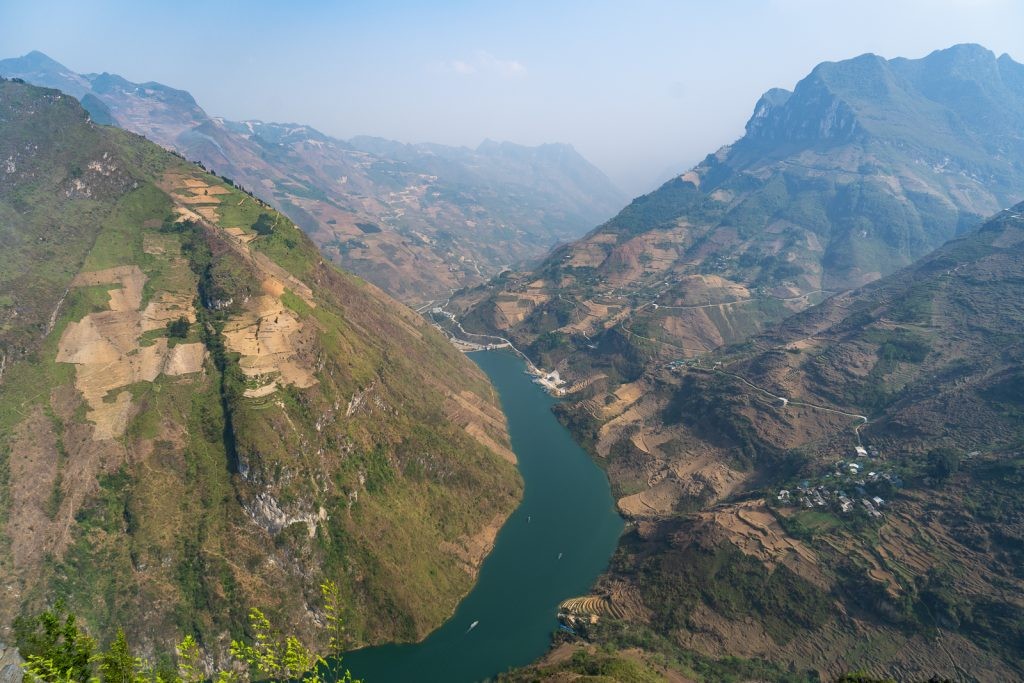 Ethnic Woman on the Ha Giang Loop
Ethnic Woman on the Ha Giang Loop
Day 2: Dong Van – Ma Pi Leng Pass – No Que River – Meo Vac – Du Gia village
- Breakfast in Dong Van
- Ma Pi Leng Pass
- Skywalk
- Nho Que River boat ride
- Lunch in Mau Due village
- Viewpoints between Mau Due and Du Gia
- Swim at Du Gia Waterfall
- Check into homestay in Du Gia
- Dinner at homestay
Day 3: Du Gia village – Lung Tam – Ha Giang
- Breakfast at homestay
- Drive back to Ha Giang, stopping at Lung Tam Village and Lung Khuy Cave
- Lunch at Caffe Yến Ngọc (Xa Lạ Quán)
- Arrive back in Ha Giang
10.2. 4-Day Ha Giang Loop Itinerary
Day 1: Ha Giang – Heaven’s Gate – Lung Khuy Cave – Yen Minh
- Breakfast in Ha Giang
- Bac Sum Pass
- Heaven’s Gate
- Twin Mountains Viewpoint
- Lung Khuy Cave
- Lunch at Caffe Yến Ngọc (Xa Lạ Quán)
- Overlooks on the way to Yen Minh
- Check into hotel in Yen Minh
- Dinner in Yen Minh
Day 2: Yen Minh – Lung Cu Flagpole – Dong Van
- Breakfast in Yen Minh
- Tham Ma Pass
- Hmong King’s Palace
- Detour to Lung Cu Flagpole
- Lunch in Lung Cu
- Drive to Dong Van
- Check into hotel in Dong Van
- Dinner in Dong Van
Day 3: Dong Van – Tu San Canyon boat tour – Du Gia
- Breakfast and coffee in Dong Van
- Ma Pi Leng Pass
- Hike up to Skywalk
- Tu San Canyon boat tour
- Lunch in Meo Vac
- Drive to Du Gia, stopping at overlooks
- Check into homestay in Du Gia
- Dinner at homestay
Day 4: Du Gia – Du Gia Waterfall – Lung Tam – Ha Giang
- Breakfast at homestay
- Swim in Du Gia Waterfall
- Drive back to Ha Giang, stopping at Lung Tam Village
- Arrive back in Ha Giang
On the Ha Giang Loop Tour you will see many couples who are enjoying their time with each other! The area is perfect for making memories and having a great time!
10.3. 6-Day Ha Giang Loop + Cao Bang Itinerary
Day 1: Ha Giang – Heaven’s Gate – Yen Minh – Dong Van
- Breakfast at Be’s Place in Ha Giang
- Pick up by drivers, pay final balance, pack bikes
- Bac Sum Pass
- Heaven’s Gate
- Twin Mountains Viewpoint
- Lunch in Yen Minh
- Tham Ma Pass
- Visit to Nô Vàng’s village
- Check into hotel in Dong Van
- Dinner with guides in Dong Van
Day 2: Dong Van – Lung Cu – Ma Pi Leng Pass – boat ride – Meo Vac
- Breakfast in Dong Van
- Detour to Lung Cu Flag Tower
- Lunch and coffee in Dong Van
- Ma Pi Leng Pass
- Boat ride on No Que River
- Check into hotel in Meo Vac
- Dinner in Meo Vac
Day 3: Meo Vac – Cao Bang – Khau Coc Cha Pass – Me Farmstay
- Breakfast and coffee in Meo Vac
- Drive to Bao Lac, stopping at a river to watch local kids jump
- Lunch in Bao Lac
- Khau Coc Cha Pass
- Stop for a drink and snack at the top of the pass
- Stop at viewpoints until reaching Me Farmstay
- Dinner at Me Farmstay
Day 4: Me Farmstay – Pac Bo and Lenin River – Yen Nhi Homestay
Day 5: Yen Nhi Homestay – Ban Gioc Waterfall – Angel Eye Mountain – Cao Bang
Day 6: Cao Bang – Ba Be Lake – Homestay
- Coffee at Nâng café
- Breakfast at a Bun Cha spot
- Drive to Ba Be Lake
- Lunch at Quán Cơm Loan Kiệm
- Ba Be Lake boat ride
- Dinner at homestay
11. What to Pack for the Ha Giang Loop
11.1. Clothing
- Layers
- Rain jacket
- Temple attire
- Good, enclosed shoes
- Gloves
11.2. Toiletries
- Feminine hygiene products
- Toilet paper
- Dual voltage items
- Bug spray
- Sunscreen
11.3. Medicine
- Advil
- First aid kit
- Stomach medicine
11.4. Technology
- Camera
- Camera strap
- Drone
- Outlet adapters
- Portable charger
- Google Translate
11.5. Miscellaneous
- Cash
- Sunglasses
- Identification
- Fanny Pack/Small Bag
12. Is Du Gia Typically Included in a Standard Ha Giang Loop Itinerary? – Unveiling the Essence of Du Gia
Yes, Du Gia is frequently included in a standard Ha Giang Loop itinerary. This picturesque village offers a tranquil escape, celebrated for its pristine natural beauty and authentic cultural encounters. Typically, the Ha Giang Loop route involves passing through Du Gia as you circle back towards Ha Giang City.
12.1. Why Du Gia Is Worth Visiting
1. Serene Natural Beauty: Du Gia is surrounded by lush landscapes, verdant rice paddies, and towering mountains, making it a perfect spot for nature lovers.
2. Cultural Immersion: The village provides a glimpse into the traditional way of life of the local ethnic communities, including the Tay and Hmong people.
3. Du Gia Waterfall: This stunning waterfall is a highlight, offering visitors a chance to swim in its cool, clear waters and enjoy the surrounding natural beauty.
12.2. Tips for Including Du Gia in Your Itinerary
1. Plan Ahead:
- While many tours include Du Gia, always confirm with your tour operator to ensure it’s part of your planned route. If you’re traveling independently, map out your route carefully, ensuring you allocate enough time to reach and enjoy Du Gia.
2. Accommodation:
- Du Gia offers several homestays that provide an authentic and immersive experience. Booking in advance is highly recommended, especially during peak tourist season.
3. Activities:
- Swimming in Du Gia Waterfall is a must-do activity. Additionally, take time to explore the village, interact with locals, and learn about their traditions.
12.3. Integrating Du Gia Into Your Ha Giang Loop Itinerary
1. Sample Itinerary: 4-Day Loop with Du Gia
- Day 1: Ha Giang – Yen Minh – Dong Van
- Day 2: Dong Van – Lung Cu – Dong Van
- Day 3: Dong Van – Meo Vac – Du Gia



